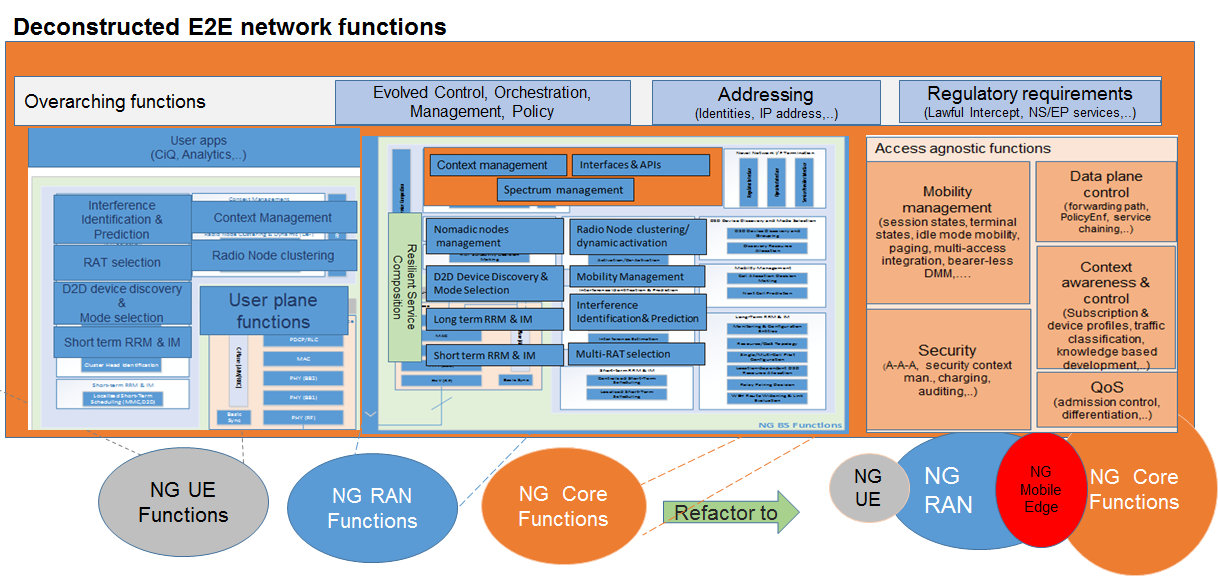5G Era Networks: The Case for Open Mobile Edge Cloud
Cagatay Buyukkoc, PhD, AT&T
1. 5G Era Networks
5G Era Networks defined a decade long transitional period1 and a new end-to-end (E2E) vision that is shaping up in industry and academia. It includes an evolved Radio-Access Network (eRAN), a next generation core, and a management/control plane that extends UE to core and beyond. It is a ubiquitous and responsive mobile-broadband network that will not only carry the (future) Internet traffic but also enable new applications and services. It is not just an air interface people sometimes equate with 5G.
It includes both:
- Evolutionary components of current generations of mobile networks under a unifying umbrella; and
- Revolutionary components that will enable energy and spectral efficiency and new resiliency (i.e., responsive, auto-manageable QoS/QoE, secure, survivable, traffic and disruption tolerant) for services to everyone and everything (applications and machines).
Many new drivers including “Immersive Experience”, “Tactile Internet” enriched by “Context Information”, and “X as a Service” will be adopted and devices such as a significant large number of IOTs will be introduced beyond the current “client-server” models, in which the network infrastructure is reduced to simplistic pipes.
This vision requires a complete revamping of the E2E architecture, services and service. This revamping includes interfaces, management and control frameworks, access and non-access protocols, functions, and advanced algorithms (e.g., AAA), and any type resources (both physical and virtual).
Service Providers (SPs) are currently deploying transformative approaches to provide network functions in appropriate infrastructures (utilizing both centralized and distributed flexible architectural concepts) and thus providing flexible and scalable capabilities according to required use cases and their traffic demands. This flexibility will be achieved using a software defined ecosystem and NFV technologies as well as data path programmability. Target architecture has to be cost and resource efficient as well as auto-managed and flexible. A large adoption of cloud computing, software defined networks and network functions virtualization require new thinking in various key areas to be able to fully utilize and monetize the capabilities presented: e.g., distributed system architecture and elastic and scalable systems.
Most of the research and innovation efforts need to be in place within the next few years to ready large field trials and testing for early deployments in 2020. This can be realized only through global collaboration and investments in key technologies and related fields. Since the required set of capabilities is very broad, establishing ecosystems (both mobile and wireline) is needed, as it will allow global participation through open frameworks.
2. Open Mobile Edge Cloud (OMEC) Vision
As mentioned earlier, various research and standardization bodies have identified that 5G systems should achieve system capacity growth by 1000 fold, energy efficiency gains in the order of 10.
Various efforts are ongoing in the RAN and Core areas to address the architectural principles outlined above. In the RAN space, one of the promising architectures towards that goal was identified as C-RAN (various flavors) as it provides a transition path to the cloud computing based architecture. C-RAN architectures have been in trials in several countries and research labs for the past few years to determine the major benefits, challenges and solutions. The major challenges are fronthaul requirements (e.g., delay, jitter, cost, technology) and the ability of centralized BBUs to provide adequate signal processing in performance targets which basically determine the spectral and energy efficiencies targeted.
Several variants of C-RAN are proposed to address the fronthaul restrictions; one of the promising architectural directions is to decouple user and control planes and progress using the SDN strategy. This also allows a major rethinking of the mobility edge (and subsequently the converged wireline/wireless edge). In this framework, basically a deconstruction of basic functions of RAN and core networks are proposed, as a next step using the deconstructed functions new architectural elements are proposed. One key area of this exercise is the introduction of a new functional node as an intersection point of these functions to be able to create a future proof architecture. This functional node, namely an Open node, will be deployed to provide seamless coverage and execute various control plane functions as well as some of the “core functions” currently placed in various nodes of EPC. More functionality related to Compute and Storage will be added to enable truly cloud capabilities in closer proximities. Since many location-based applications are on the rise (social, analytics, video, etc.) fronthaul load will be considerably higher in the future. A requirement on local storage, compute and networking processing of “edge” services almost forces a new architectural direction.
ETSI/MEC2 and “Fog computing3” are efforts in this direction; trying to address similar issues and identifying that a substantial amount of storage, communication, control, configuration, measurement and management should be placed at the “edge” of a network, in addition to the current cloud paradigms. This idea is based on the premise to certain extensions of cloud computing architectures to the network edge. Figure 1 is a functional decomposition of NG user equipment (UE), RAN and core functions for an E2E architecture of mobile networks in the 5G era. All these are related approaches but much more needs to be done. A proposed framework summary is provided below.
Figure 1. The functional decomposition of NG UE, RAN, core and E2E functions4
3. Concluding Remarks
The deconstruction of functions is a prelude to reconstruction and optimal placement of functionalities, much more than networking, to refactored nodes to address all the considerations outlined above. It is envisioned that NG Mobile edge (subsequently converged edge) will be the center of all 5G era networks with compute and storage functionalities attached, as will be described below briefly. The Open Mobile Edge Cloud (OMEC) concept is a description of this framework.
1 “Networks and Devices for the 5G Era”, Bangerter, Talwar, S., Arefi, R., Stewart, S.IEEE Communications Magazine, February 2014 pgs. 90-96.
2 See, ETSI/MEC overview : http://www.etsi.org/technologies-clusters/technologies/mobile-edge-computing
3 See, http://www.openfogconsortium.org/ for Fog networks related work
4 Decomposition vision created by the author based on METIS work cited earlier
 Cagatay Buyukkoc works for AT&T Architecture and Design organization as a Lead MTS, leading efforts on various SDN/NFV frameworks and RAN evolution target architecture.
Cagatay Buyukkoc works for AT&T Architecture and Design organization as a Lead MTS, leading efforts on various SDN/NFV frameworks and RAN evolution target architecture.
He is also the co-lead of IEEE SDN initiative preindustrial committee. He graduated from METU, with EE BS and MS degrees and a PhD degree from University of California, Berkeley in EECS. Cagatay also obtained an Executive MBA on International Business from Wharton.
He held various technical and management positions in AT&T Bell Labs, Lucent Technologies, ZTE, Cisco and AT&T.
Editor:
 Francesco Benedetto received the Dr. Eng. degree in Electronic Engineering from the University of ROMA TRE, Rome, Italy, in May 2002, and the PhD degree in Telecommunication Engineering from the University of ROMA TRE, Rome, Italy, in April 2007. Since 2008, he has been an Assistant Professor of Telecommunications at the Third University of Rome (2008-2012, Applied Electronics Dept.; 2013-Present, Economics Dept.), where he currently teaches the course of "Elements of Telecommunications" (formerly Signals and Telecommunications) in the Computer Engineering degree and the course of "Software Defined Radio" in the Laurea Magistralis in Information and Communication Technologies.
Francesco Benedetto received the Dr. Eng. degree in Electronic Engineering from the University of ROMA TRE, Rome, Italy, in May 2002, and the PhD degree in Telecommunication Engineering from the University of ROMA TRE, Rome, Italy, in April 2007. Since 2008, he has been an Assistant Professor of Telecommunications at the Third University of Rome (2008-2012, Applied Electronics Dept.; 2013-Present, Economics Dept.), where he currently teaches the course of "Elements of Telecommunications" (formerly Signals and Telecommunications) in the Computer Engineering degree and the course of "Software Defined Radio" in the Laurea Magistralis in Information and Communication Technologies.
He is a Senior Member of the Institution of Electrical and Electronic Engineers (IEEE), and and a member of the following IEEE Societies: IEEE Standard Association, IEEE Young Professionals, IEEE Software Defined Networks, IEEE Communications, IEEE Signal Processing, IEEE Vehicular Technology. Finally, He is also a member of CNIT (Italian Inter-Universities Consortium for Telecommunications). He is the Chair of the IEEE 1900.1 WG on dynamic spectrum access, the Chair of the Int. Workshop on Signal Processing fo Secure Communciations (SP4SC), and the co-Chair of the WP 3.5 on signal processing for ground penetrating radar of the European Cost Action YU1208.
Subscribe to IEEE Softwarization
Join our free SDN Technical Community and receive IEEE Softwarization.
Article Contributions Welcomed
Download IEEE Softwarization Editorial Guidelines for Authors (PDF, 122 KB)
If you wish to have an article considered for publication, please contact the Managing Editor at sdn-editor@ieee.org.
Past Issues
IEEE Softwarization Editorial Board
Laurent Ciavaglia, Editor-in-Chief
Mohamed Faten Zhani, Managing Editor
TBD, Deputy Managing Editor
Syed Hassan Ahmed
Dr. J. Amudhavel
Francesco Benedetto
Korhan Cengiz
Noel Crespi
Neil Davies
Eliezer Dekel
Eileen Healy
Chris Hrivnak
Atta ur Rehman Khan
Marie-Paule Odini
Shashikant Patil
Kostas Pentikousis
Luca Prete
Muhammad Maaz Rehan
Mubashir Rehmani
Stefano Salsano
Elio Salvadori
Nadir Shah
Alexandros Stavdas
Jose Verger




